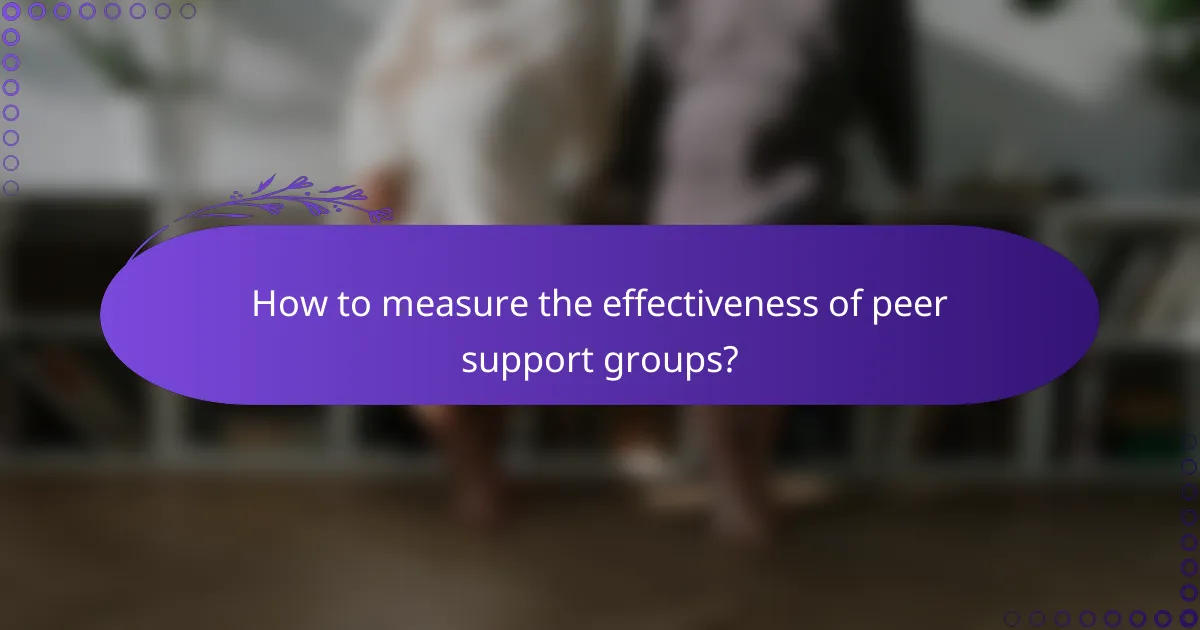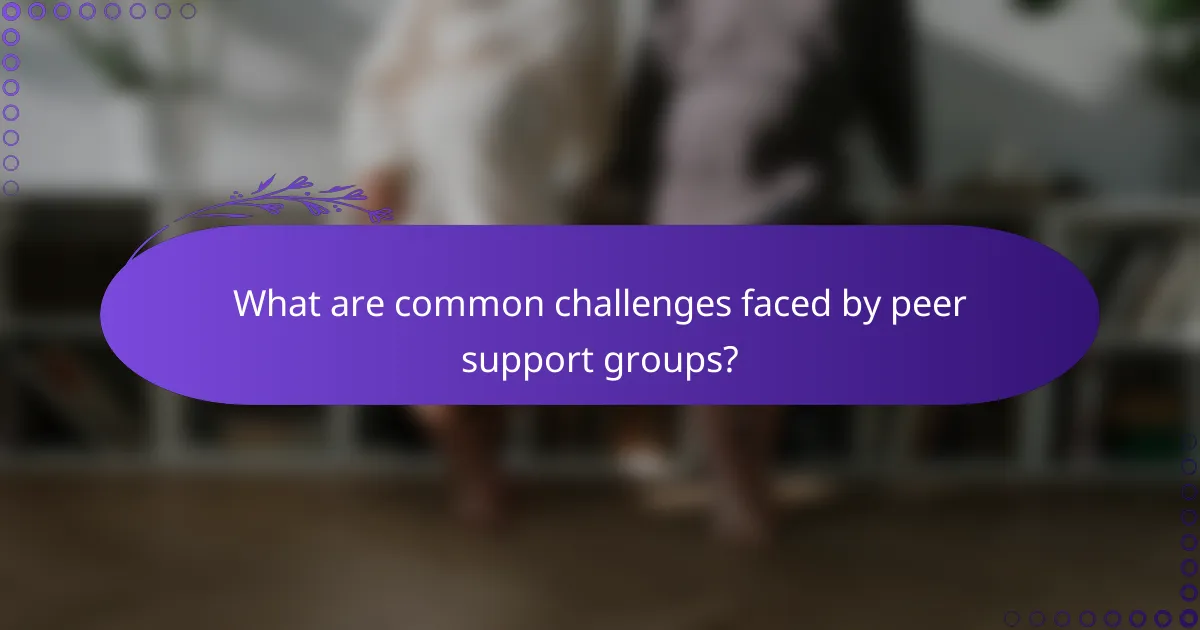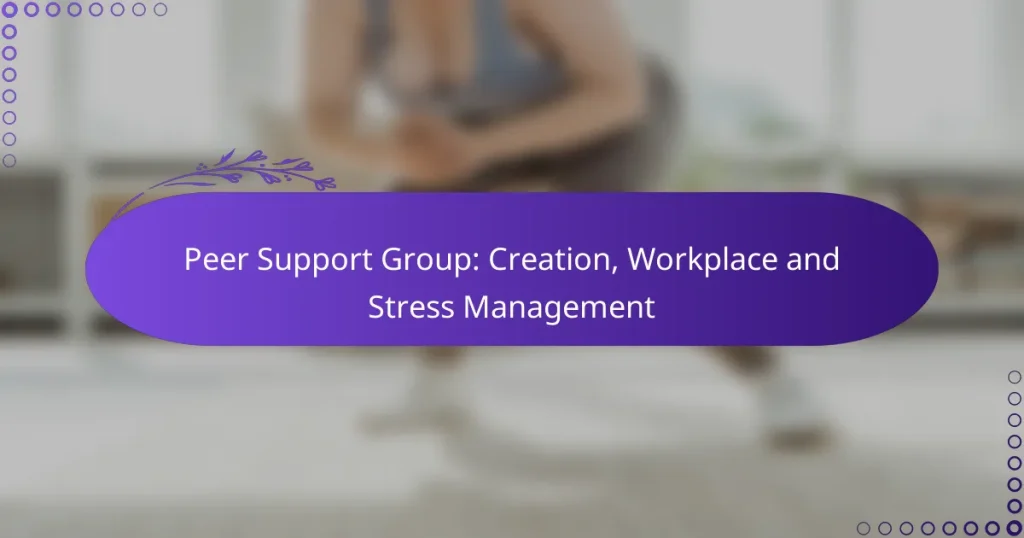Peer support groups in the workplace are essential for fostering a supportive environment that aids in stress management and enhances employee well-being. By establishing clear objectives and encouraging diverse participation, these groups create a sense of community where individuals can share experiences, provide emotional support, and exchange coping strategies. Implementing a structured framework for these groups can significantly improve communication and mutual assistance among employees, leading to a healthier workplace culture.

How to create an effective peer support group in the workplace?
Creating an effective peer support group in the workplace involves clear objectives, diverse participation, and structured meetings. These elements foster a supportive environment that helps employees manage stress and enhance their well-being.
Define group objectives
Clearly defined objectives are essential for a peer support group. Objectives should focus on promoting mental health, providing emotional support, and facilitating open communication among employees. Consider setting specific goals, such as reducing workplace stress or improving team cohesion.
Involve potential members in the objective-setting process to ensure the goals resonate with their needs. This collaborative approach can increase engagement and commitment to the group’s purpose.
Recruit diverse participants
Diversity in participation enriches the peer support group by bringing various perspectives and experiences. Aim to include employees from different departments, backgrounds, and levels of experience. This variety can enhance problem-solving and foster a more inclusive environment.
Utilize internal communication channels, such as newsletters or intranet postings, to invite employees to join. Highlight the benefits of participation, such as improved mental health and stronger workplace relationships, to encourage sign-ups.
Establish ground rules
Ground rules are crucial for maintaining a safe and respectful environment within the peer support group. Establish guidelines that promote confidentiality, active listening, and non-judgmental support. Ensure all participants understand and agree to these rules before meetings commence.
Regularly revisit and revise the ground rules as necessary to adapt to the group’s evolving dynamics. This practice helps maintain a constructive atmosphere and reinforces the group’s objectives.
Schedule regular meetings
Consistency in meeting schedules is vital for the success of a peer support group. Aim to hold meetings on a regular basis, such as weekly or bi-weekly, to foster ongoing support and connection among members. Choose a time that accommodates most participants to maximize attendance.
Consider varying the meeting format to keep sessions engaging. For example, alternate between open discussions, structured activities, and guest speakers to maintain interest and encourage participation.
Provide training for facilitators
Trained facilitators play a key role in guiding peer support group discussions and ensuring a positive experience for participants. Provide training that covers active listening, conflict resolution, and mental health awareness to equip facilitators with the necessary skills.
Encourage facilitators to seek feedback from group members regularly. This feedback can help them improve their facilitation techniques and adapt to the group’s needs, ultimately enhancing the overall effectiveness of the support group.

What are the benefits of peer support groups for stress management?
Peer support groups offer significant advantages for stress management by fostering a sense of community and shared experience among participants. These groups provide emotional support, practical advice, and coping strategies, which can lead to improved well-being and reduced stress levels.
Improved mental health
Participating in peer support groups can lead to enhanced mental health by providing a safe space for individuals to express their feelings and challenges. Sharing experiences with others who understand similar struggles can alleviate feelings of isolation and anxiety.
Moreover, these groups often encourage open discussions about mental health, helping members to recognize and address their own issues. This collective approach can lead to increased awareness and proactive management of mental health challenges.
Enhanced employee engagement
Peer support groups can significantly boost employee engagement by creating a supportive workplace culture. When employees feel supported by their peers, they are more likely to be motivated and committed to their work.
These groups can also facilitate better communication and collaboration among team members, leading to improved morale and productivity. Engaged employees tend to contribute more positively to the workplace, which can enhance overall organizational performance.
Increased resilience
Joining a peer support group can help individuals build resilience by equipping them with coping strategies and problem-solving skills. Members learn from each other’s experiences, which can provide new perspectives on handling stress and adversity.
Additionally, the emotional support received from peers can reinforce an individual’s ability to bounce back from setbacks. This shared resilience can create a more robust support network, making it easier for individuals to navigate stressful situations in both personal and professional contexts.

How to implement peer support groups in major US companies?
To implement peer support groups in major US companies, organizations should focus on creating a structured framework that encourages open communication and mutual assistance among employees. This involves identifying key personnel, providing training, and establishing clear objectives for the groups.
Case study: Google
Google has successfully integrated peer support groups into its workplace culture by fostering an environment of psychological safety. Employees are encouraged to share their experiences and challenges, which helps in reducing stress and enhancing overall well-being.
The company offers training sessions for group facilitators, ensuring they are equipped to handle sensitive topics and maintain a supportive atmosphere. Regular feedback loops are established to assess the effectiveness of these groups and make necessary adjustments.
Case study: Microsoft
Microsoft’s approach to peer support groups emphasizes inclusivity and diversity. The company has implemented various support networks tailored to different employee demographics, such as new parents or those facing mental health challenges.
These groups meet regularly, providing a platform for sharing resources and coping strategies. Microsoft also tracks participation and outcomes, using this data to refine their support initiatives and promote engagement across the organization.
Case study: Amazon
Amazon has introduced peer support groups as part of its employee wellness strategy, focusing on stress management and work-life balance. These groups are often formed around specific interests or challenges, allowing employees to connect on a personal level.
To ensure effectiveness, Amazon provides guidelines for group leaders and encourages the sharing of best practices among different teams. The company also offers incentives for participation, such as wellness credits, which further motivates employees to engage in these supportive networks.

What criteria should be considered when selecting peer support group leaders?
When selecting peer support group leaders, consider their qualifications, interpersonal skills, and ability to foster a supportive environment. Effective leaders should possess a blend of experience, communication skills, and empathy to guide participants through stress management and mental health challenges.
Experience in mental health
Leaders should have a background in mental health, whether through formal education, training, or personal experience. This knowledge equips them to understand various mental health issues and the dynamics of peer support. Ideally, they should have experience facilitating discussions or working in related fields, such as counseling or social work.
Consider candidates who have completed relevant certifications or training programs, which can enhance their credibility. For example, training in active listening or crisis intervention can be beneficial in managing group dynamics effectively.
Strong communication skills
Effective communication is crucial for peer support group leaders. They must be able to articulate thoughts clearly and encourage open dialogue among participants. Leaders should be skilled in both verbal and non-verbal communication, ensuring that everyone feels heard and valued.
Look for individuals who can adapt their communication style to suit different group members. This includes being able to simplify complex concepts and ask open-ended questions to stimulate discussion. Regular feedback from group members can also help leaders refine their communication techniques.
Empathy and understanding
Empathy is essential for peer support group leaders, as it allows them to connect with participants on a personal level. Leaders should demonstrate genuine concern for the well-being of others, creating a safe space for sharing experiences and emotions. This understanding fosters trust and encourages openness within the group.
To assess empathy, consider candidates who have demonstrated compassion in previous roles or personal experiences. Training in emotional intelligence can also enhance a leader’s ability to relate to others and respond appropriately to their needs.

How to measure the effectiveness of peer support groups?
Measuring the effectiveness of peer support groups involves assessing various factors such as employee feedback, participation rates, and the impact on absenteeism due to stress. These indicators provide insights into how well the groups are functioning and their overall benefit to workplace well-being.
Employee feedback surveys
Employee feedback surveys are a direct way to gauge the effectiveness of peer support groups. These surveys can include questions about the perceived value of the group, the quality of support received, and suggestions for improvement. Aim for a response rate of at least 70% to ensure the results are representative.
When designing surveys, consider using a mix of quantitative ratings and qualitative open-ended questions. This approach allows for both measurable data and personal insights, helping to identify specific strengths and areas for growth within the support group.
Participation rates
Participation rates are a crucial metric for evaluating peer support groups. High attendance suggests that employees find value in the sessions, while low participation may indicate a lack of interest or awareness. Tracking attendance over time can reveal trends and help identify factors that influence engagement.
To improve participation, consider promoting the group through internal communications and offering incentives for attendance, such as refreshments or recognition programs. Regularly reviewing participation data can help adjust strategies to enhance involvement.
Reduction in stress-related absenteeism
A decrease in stress-related absenteeism is a strong indicator of the effectiveness of peer support groups. By providing a platform for employees to share experiences and coping strategies, these groups can help mitigate stress and improve overall mental health. Monitoring absenteeism rates before and after the implementation of support groups can provide valuable insights.
Employers should track absenteeism data regularly and compare it to industry benchmarks. A reduction of even a few percentage points can signify a positive impact. Additionally, consider conducting exit interviews to understand the role of peer support in employees’ decisions to stay or leave the organization.

What are common challenges faced by peer support groups?
Peer support groups often encounter various challenges that can hinder their effectiveness. These include issues such as participant engagement, confidentiality concerns, and the need for trained facilitators to guide discussions.
Participant Engagement
Maintaining participant engagement is a significant challenge for peer support groups. Members may have varying levels of commitment, leading to inconsistent attendance and participation. To address this, groups can establish clear goals and expectations, and regularly check in with members to encourage ongoing involvement.
Confidentiality Concerns
Confidentiality is crucial in peer support settings, as members often share personal experiences and sensitive information. Ensuring that all participants understand the importance of confidentiality can help build trust. Groups should establish ground rules regarding privacy and consider using anonymous platforms for discussions when necessary.
Need for Trained Facilitators
Effective peer support groups often require trained facilitators to guide conversations and manage group dynamics. Without proper training, facilitators may struggle to handle conflicts or sensitive topics. Organizations should invest in training programs for facilitators to equip them with the skills needed to support participants effectively.


